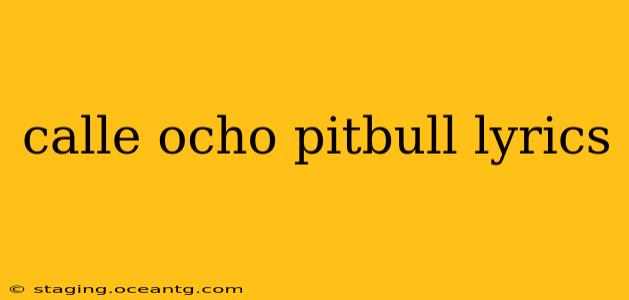Pitbull's "Calle Ocho" is more than just a catchy tune; it's a vibrant anthem celebrating Miami's Cuban culture and its infectious energy. This deep dive explores the lyrics, the song's cultural significance, and the reasons behind its enduring popularity. We'll also tackle some frequently asked questions surrounding this iconic track.
What is the meaning behind the song "Calle Ocho"?
"Calle Ocho," named after the famous street in Little Havana, Miami, is a passionate tribute to the area's rich Cuban heritage and its lively atmosphere. The lyrics paint a vivid picture of the street's vibrant pulse – the music, the dancing, the people, and the overall feeling of community and pride. It’s not just about the physical location; it's about the spirit and the culture it represents. Pitbull, himself a Miami native with Cuban roots, pours his heart into expressing his love and appreciation for this significant part of his identity and heritage. The song celebrates the energy, the resilience, and the unique character that defines Calle Ocho and its people.
What are the main themes explored in the lyrics of "Calle Ocho"?
The song's central theme revolves around celebrating Cuban culture and the spirit of Little Havana. Several sub-themes weave throughout the lyrics:
- Pride in heritage: The lyrics repeatedly emphasize the pride and joy associated with Cuban culture, its music, and its people.
- Community and unity: "Calle Ocho" embodies a sense of community and belonging, showcasing the togetherness found within the Cuban-American community.
- Celebration of life: The exuberant rhythm and celebratory lyrics reflect the zest for life and the vibrancy of the Cuban culture.
- The power of music: Music acts as a unifying force, bringing people together and fostering a sense of shared identity.
How does "Calle Ocho" reflect Miami's Cuban culture?
"Calle Ocho" acts as a powerful cultural ambassador, capturing the essence of Miami's Little Havana. The song's use of Spanish, the references to specific locations, and the overall festive energy accurately represent the neighborhood's vibrant atmosphere. The music incorporates traditional Cuban rhythms and instrumentation, blending seamlessly with contemporary sounds, thereby reflecting the dynamic fusion of old and new that characterizes the community. It's a celebration of the traditions while simultaneously acknowledging the area's modern evolution.
What makes "Calle Ocho" such a popular and enduring song?
The enduring popularity of "Calle Ocho" stems from several factors:
- Catchy melody and rhythm: The song features a highly infectious melody and rhythm, making it incredibly memorable and danceable.
- Universal theme of celebration: The song's celebration of culture and community resonates with audiences worldwide, transcending language and cultural barriers.
- Pitbull's charisma: Pitbull's energetic performance and charismatic delivery enhance the song's appeal.
- Cultural significance: The song's association with Miami's vibrant Little Havana adds to its cultural significance and makes it a meaningful anthem for many.
What language is "Calle Ocho" sung in?
While primarily sung in English, "Calle Ocho" incorporates elements of Spanish, reflecting the bilingual nature of Miami's Cuban community. This blending of languages is part of what makes the song so authentic and representative of the culture it celebrates. The Spanish phrases add depth and authenticity to the song, enriching its cultural context.
Is there a music video for "Calle Ocho"?
Yes, there is a music video for "Calle Ocho." The video vividly portrays the energetic atmosphere of Calle Ocho in Little Havana, further solidifying the song's connection to its namesake location and enhancing its cultural impact. The vibrant visuals perfectly complement the song’s lively rhythm and celebratory lyrics.
By understanding the lyrics, the cultural context, and the reasons behind its enduring popularity, one can truly appreciate "Calle Ocho" not just as a song, but as a powerful representation of Miami's Cuban culture and the enduring spirit of its people.
